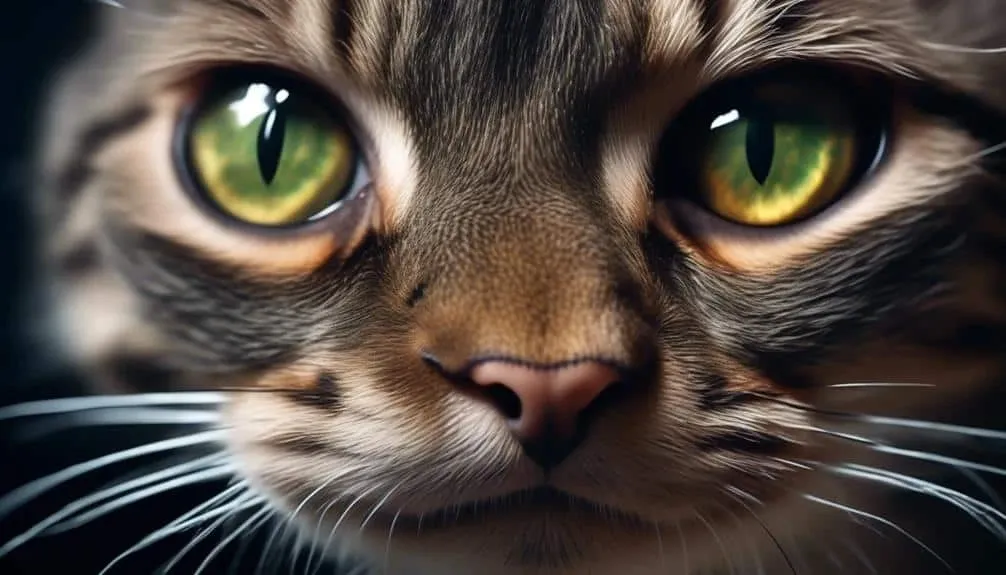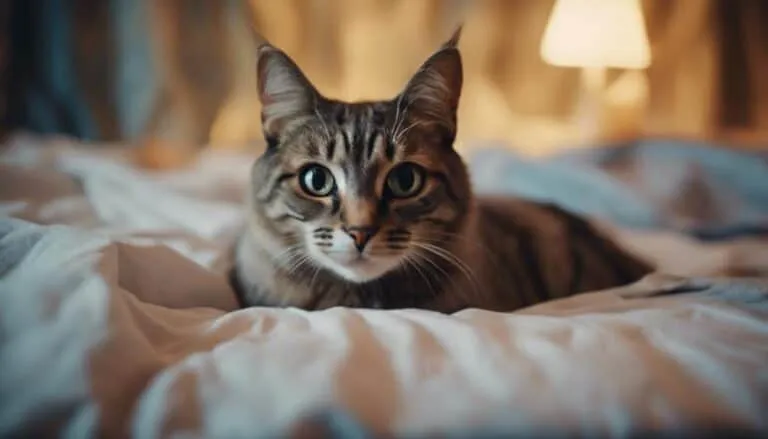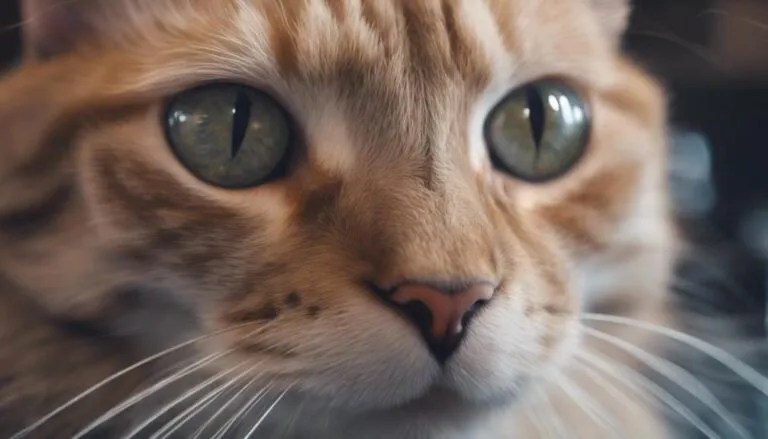The Best Fluffy Pancakes recipe you will fall in love with. Full of tips and tricks to help you make the best pancakes.

The unsuspecting cat, a beloved companion to many, may unknowingly harbor a sinister secret. Deep within their furry exteriors, terrifying parasitic larvae lie in wait, ready to invade their unsuspecting hosts.
These larvae, known as warbles, can silently infiltrate a cat's body, causing a range of health issues that may go unnoticed until it's too late. As we delve into the hidden danger of these insidious creatures, we uncover a world filled with mystery, fear, and the urgent need for awareness.
Brace yourself, dear reader, for the dark tale that lies ahead, as we unravel the secrets of the terrifying parasitic larvae that invade cats.
Key Takeaways
- Warbles in cats are caused by larvae of the Cuterebra fly, which typically infect rodents or rabbits.
- Cats can become accidental hosts of warbles if they come into contact with the larvae while hunting.
- Signs of warbles in cats include wounds or swelling under the skin, matted fur, and potential infections.
- It is important to consult a veterinarian for proper diagnosis and treatment of warbles in cats.
The Dangers of Warble Infection
Warble infection in cats poses significant risks to their health and well-being. Common symptoms of warbles in cats include the presence of a wound or swelling under the skin, usually around the head or neck. In some cases, an air hole may be visible, which the larvae use to breathe. Over-grooming and matted fur may also be observed. If left untreated, the wound can become infected, leading to pus and pain. In rare instances, the larvae can migrate to the nervous system, eyes, or respiratory system, causing additional symptoms such as lethargy, vision problems, and coughing.
When it comes to treatment options for warbles in cats, it is crucial to consult a veterinarian. Squeezing the larva from beneath the skin can cause further inflammation and infection. Vets typically remove the larva in one piece using forceps. The wound may require cleaning or flushing, and antibiotics and anti-inflammatories may be prescribed. Depending on the severity of the abscess and the cat's temperament, sedation or anesthesia may be necessary during treatment.
Recognizing the Signs of Warbles in Cats
Cat owners should be aware of the signs that indicate their cat may have been invaded by parasitic larvae known as warbles. Recognizing warbles in cats is crucial for timely treatment and prevention. Here are the key symptoms and treatment options:
- Symptoms of Warbles in Cats:
- Swelling or a wound under the skin, typically around the head or neck.
- An air hole used by the larvae to breathe and matted fur from over-grooming.
- Infection, leading to pus, pain, and potential migration to other body parts.
- Treatment for Cats with Warbles:
- Consult a veterinarian for proper diagnosis and treatment.
- Removal of the larva using forceps by a professional.
- Cleaning or flushing the wound and administration of antibiotics and anti-inflammatories if necessary.
- Sedation or anesthesia may be required for severe cases or difficult temperaments.
To protect your cat from warble infection:
- Prevent hunting of rabbits or rodents.
- Keep cats indoors or regularly inspect them for wounds and signs of larvae to minimize the risk.
Understanding the Causes of Warbles in Cats
The occurrence of warbles in cats is primarily caused by their exposure to the larvae of the Cuterebra fly. These flies typically infect rodents or rabbits but can accidentally invade cats through hunting behavior or small wounds in the skin.
When cats come into contact with the larvae while hunting, the larvae can enter the cat's body and develop, usually under the skin, causing warbles.
To prevent warble transmission, it is important to prevent cats from hunting rabbits or rodents. Keeping cats indoors or regularly inspecting them for wounds and larvae can help reduce the risk.
If a cat becomes infected with warbles, effective treatment involves consulting a veterinarian for proper diagnosis and removal of the larvae using forceps. The wound may need to be cleaned, and antibiotics and anti-inflammatories may be prescribed to prevent infection and promote healing.
Proper Care for Cats With Warbles
Experienced veterinary care is essential for effectively managing and treating cats that have been infected with warbles. When it comes to treating warbles effectively, there are several important steps to consider:
- Prompt Veterinary Consultation:
- Seek immediate veterinary care if you suspect your cat has warbles.
- A professional assessment is crucial for accurate diagnosis and appropriate treatment.
- Medical Intervention:
- Vets may remove the larva using forceps, ensuring the complete removal of the parasite.
- The wound should be thoroughly cleaned and flushed to prevent infection.
- Antibiotics and anti-inflammatories may be prescribed to manage any existing infections or inflammation.
While some may consider home remedies for warble infection, it is important to note that self-treatment or unverified remedies can be risky and potentially harmful to the cat. Seeking professional veterinary care is the safest and most effective approach to ensure the well-being of your feline companion.
Diagnosis, Prognosis, and Prevention of Warbles in Cats
Diagnosing, prognosing, and preventing warbles in cats requires a comprehensive understanding of the parasite and its effects on feline health.
Most veterinarians diagnose warbles through visual inspection, considering the appearance of the larva, the cat's history, and any skin lesions. In some cases, microscopic inspection or consultation with a parasitologist may be necessary for an accurate diagnosis.
Although most cats make a complete recovery from warbles, healing may take time. The severity of the abscess, the presence of fever or sepsis, and the migration of the larva to the nervous system, eyes, or respiratory system can all affect the prognosis.
To prevent warbles, it is crucial to prevent hunting of rabbits and rodents. Keeping cats indoors or regularly inspecting them for wounds and larvae can help reduce the risk.
Frequently Asked Questions
How Do Cats Become Accidental Hosts of Warbles?
Cats become accidental hosts of warbles when they come into contact with the larvae while hunting rodents or rabbits. The larvae enter through small wounds in the cat's skin and develop under the skin, causing irritation and infection. Warbles can affect a cat's health and behavior, leading to symptoms such as swelling, matted fur, and in rare cases, migration to other body systems. Preventing hunting of rabbits and rodents is the best way to prevent warbles in cats.
Can Warbles in Cats Cause Symptoms in the Nervous System, Eyes, or Respiratory System?
Warbles in cats can potentially cause symptoms in the nervous system, eyes, and respiratory system. This includes neurological manifestations, ocular complications, and respiratory issues. Prompt veterinary care is crucial for proper diagnosis and treatment.
What Is the Best Course of Action if I Suspect My Cat Has Warbles?
If you suspect your cat has warbles, it is best to consult a veterinarian. Treatment options may include surgical removal of the larvae, wound cleaning, and the use of antibiotics and anti-inflammatories. Potential complications can arise if the larvae migrate to the nervous system, eyes, or respiratory system.
How Is the Diagnosis of Warbles in Cats Made?
The diagnosis of warbles in cats is typically made through visual inspection by a veterinarian. The appearance of the larvae, along with the cat's history and skin lesion, aids in diagnosis. Occasionally, microscopic inspection or consultation with a parasitologist is necessary.
Is There a Way to Prevent Warble Infection in Cats?
Preventing warble infection in cats is crucial. Early detection is important. Limiting outdoor access and regularly inspecting cats for wounds and larvae can help reduce the risk. Consult a veterinarian for proper diagnosis and treatment.
Conclusion
In conclusion, warble infection in cats can pose a hidden danger and should be taken seriously by cat owners. Recognizing the signs of warbles, understanding the causes, providing proper care, and seeking prompt diagnosis and treatment are essential for the well-being of the feline companions.
By following preventive measures, such as monitoring cats during outdoor activities and consulting with a veterinarian, owners can protect their cats from this terrifying condition.








